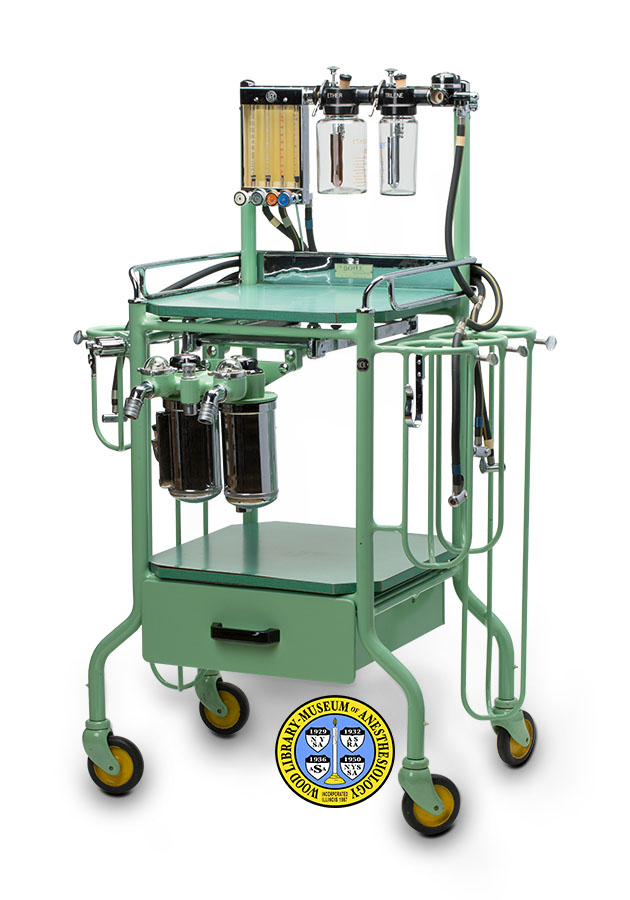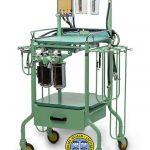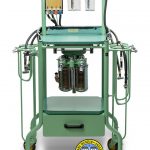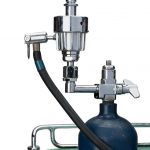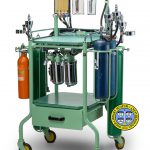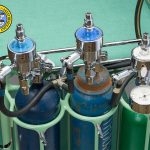BOC Boyle Machine
Born in Barbados, Henry E. G. Boyle, OBE, FRCS, DA (1875-1941) made his career as an anesthesiologist at London's St. Bartholomew's Hospital. A leader of the specialty in Great Britain, he is best known for two pieces of apparatus, the Boyle machine and the Boyle-Davis gag. Dr. Boyle introduced his anesthesia machine in 1917. It was a modification of the American-made Gwathmey-Woolsey apparatus. Coxeter, a London instrument maker, manufactured Dr. Boyle's machine. It was so successful that it remained in production for fifty years, well beyond the acquisition of Coxeter by the British Oxygen Company (BOC) in 1939. BOC soon added a carbon dioxide absorber, mounted on a sliding bracket under the tabletop.
The example shown here was probably made between 1950 and 1955. It could administer nitrous oxide, oxygen, cyclopropane and carbon dioxide gases. Unlike American machines, the compressed gas tanks were not attached to this machine by means of cylinder yokes. Instead, separate regulators were attached to the cylinders, and these were linked to the machine by rubber hoses. The machine also has sight-feed vaporizers, called "Boyle bottles", to administer the volatile agents ether and Trilene.
Catalog Record: BOC Boyle Machine BOC Boyle Machine
Access Key: amxs
Accession No.: 2000-04-03-3
Title: Boyle apparatus. / British Oxygen Company.
Corporate Author: British Oxygen Company.
Title variation: Alt Title
Title: BOC Boyle model H anesthesia machine.
Publisher: London, England : British Oxygen Company, [between ca. 1946 and 1955].
Physical Description: 1 anesthesia machine : metals, plastics, laminated board , rubber, glass, enamel; 125 x 82 x 79 cm.
Subject: Anesthesia Machines.
Subject: Anesthesia, Inhalation – instrumentation.
Subject: Carbon Dioxide.
Subject: Cyclopropane.
Subject: Ether, Ethyl.
Subject: Nitrous Oxide.
Subject: Oxygen.
Subject: Trichloroethylene.
Web Link: https://www.woodlibrarymuseum.org/museum/item/1005/boc-boyle-machine
Note Type: General
Notes: The first year in the date range is based on the earliest published image of a Boyle Model G machine found by the cataloger (Duncan & Flockhart, p. 48.) The second year in date range is based on that British Oxygen Co. publication featuring the “MS 4/4C Model H”, which post-dates the cataloged object. The full width of the apparatus cannot be measured without all of the cylinders and their regulating gauges in place; the WLM does not currently own a carbon dioxide cylinder of the correct size.
Note Type: With
Notes: The manufacturer’s original wooden packing crate (137 x 89 x 66 centimeters) was broken up upon opening, and was deaccessioned.
Note Type: Citation
Notes: Boyle HEG. Experiences in the use of nitrous oxide and oxygen with rebreathing in military surgery. Lancet. 1917;2:667-669.
Note Type: Citation
Notes: British Oxygen Co. Anaesthetic apparatus, section A. Wembley, Middlesex: The British Oxygen Co. Ltd., Medical Section, ca. 1950-1955.
Note Type: Citation
Notes: British Oxygen Co. The Boyle apparatus (overseas models). Brentford, Middlesex, England, British Oxygen Co., February, 1955. In: British Oxygen Company File. Archives. Located at: Wood Library-Museum of Anesthesiology, Schaumburg, Illinois.
Note Type: Citation
Notes: Duncan, Flockhart & Co. The history of Duncan, Flockhart & Co., commemorating the centenaries of ether & chloroform. Edinburgh: Duncan, Flockhart & Co., 1946:48.
Note Type: Citation
Notes: Watt OM. The evolution of the Boyle apparatus, 1917-1967. Anaesthesia. January, 1968;23(1):103-118.
Note Type: Citation
Notes: Wilkinson DJ. A. Charles King: a unique contribution to anesthesia. J Royal Soc Med. August, 1987;80(8):510-514.
Note Type: Physical Description
Notes: One anesthesia machine; The frame is composed of metal tubing, with an upper back bar, middle back bar, and a lower back bar, an upper platform and a lower platform, and one drawer; Both platforms are made of a green laminated fiberboard (possibly Formica); These platforms are fitted into the frame and are easily removed; To left and right, the frame holds cage-like supports for compressed gas cylinders;
From front to back, the left side of the frame holds one cylinder yoke for cyclopropane, one short support for a small carbon dioxide cylinder, and one long support for an oxygen cylinder; From front to back, the right side of the frame holds mid-length supports for two nitrous oxide cylinders and one long support for an oxygen cylinder;
As received, the machine came with two regulator heads for oxygen, two for nitrous oxide, one for cyclopropane and one for carbon dioxide; For purposes of photography, this machine was married to one cyclopropane, two oxygen and two nitrous oxide cylinders from the collection; At the present time, the WLM does not own any white oxygen cylinders, and has no carbon dioxide cylinders of the correct size to fit this machine;
The upper back bar holds four components; From left to right these components are a rotameter (flowmeter) block, two vaporizers and an oxygen flush mechanism; Mounted on the far left of the back bar, the rotameter block contains one tube each for oxygen (color coded white), carbon dioxide (gray), cyclopropane (orange) and nitrous oxide (blue); The associated control knobs are color coded to match; A circular label on the rotameter block reads: “Medical [new line] B.O.C. [new line] Division”; The block is connected by rubber tubes to the cylinder regulator heads;
To the right of this block is a sight feed vaporizer (known as a Boyle bottle) calibrated for ether; To the right of this is a smaller Boyle bottle calibrated for Trilene (trichloroethylene); Each vaporizer is governed by a toggle lever marked “ON [new line] OFF”; The oxygen flush mechanism is mounted at the far right of the back bar; The top of the mechanism has a circular label that reads: “BRITISH OXYGEN CO. [new line] MEDICAL DIVISION”; The control lever of the mechanism is marked: “EMERGENCY [new line] OXYGEN [new line] ON”;
The middle back-bar is mounted just above the upper platform; this is labeled: “The BOYLE [new line] Apparatus [new line] By The British Oxygen Co. Ltd.”; A sliding bracket is mounted on the frame below the upper platform; This bracket holds the carbon dioxide absorber; The absorber consists of two metal canisters with pop-off valves; This assembly can be pulled forward until it is clear of the platform; When fully retracted, the forward portion of the absorber extends somewhat beyond the forward edge of the covering platform; A sliding bracket is mounted on the frame below the upper platform; This bracket holds the carbon dioxide absorber; The absorber consists of two metal canisters with pop-off valves; This assembly can be pulled forward until it is clear of the platform; When fully retracted, the forward portion of the absorber extends somewhat beyond the forward edge of the covering platform;
A drawer is mounted on the frame under the lower platform; The four rubber wheels are mounted in casters; These wheels are in poor condition; With the wheels turned inward, the width of the apparatus is approximately 75 centimeters ; With the absorber fully retracted under the tabletop, the depth is approximately 52 centimeters.
Note Type: Reproduction
Notes: Photographed by Mr. Steve Donisch, January 14, 2016.
Note Type: Historical
Notes: Born in Barbados, Henry E. G. Boyle, OBE, FRCS, DA (1875-1941), made his career as an anesthesiologist at London’s St. Bartholomew’s Hospital. A leader of the specialty in Great Britain, he is best known for two pieces of apparatus, the Boyle machine and the Boyle-Davis gag. Dr. Boyle had examined the American Gwathmey-Woolsey apparatus when it was exhibited in London in 1915, and was struck by its sight-feed ether vaporizer. Two years later, he introduced his own anesthesia apparatus. It was manufactured for him by Coxeter, a London instrument maker. Coxeter was also one of the first companies in the world to make cylinders of compressed nitrous oxide.
Boyle’s original, 1917 apparatus delivered nitrous oxide, oxygen and ether. It incorporated a modification of the Gwathmey-Woolsey vaporizer in a larger and more complex apparatus. The machine was so successful that it remained in production for fifty years, well beyond the acquisition of Coxeter by the British Oxygen Company (BOC) in 1939. As new anesthetic agents became available, each modification of the Boyle machine continued to include one or more sight-feed vaporizers; these came to be widely known as “Boyle bottles”.
By 1930, Coxeter had introduced the basic configuration seen in this example: an open frame made of metal tubes, with a back-bar supporting the vaporizers and flowmeters, a tabletop, a low shelf, and cage supports for the cylinders. These supports restricted the cylinder size for each gas. This continued in use, with modifications, into the 1960s. Initially, the cylinders were connected to the machine by means of separate pressure regulators and rubber tubes, rather than the integrated yokes that were common in American machines. BOC began using cylinder yokes around 1950; the cataloged machine has only one, for cyclopropane.
In 1937, Coxeter introduced a new flowmeter design, the rotameter. American servicemen in England during WWII liked it so much that similar designs were soon adopted by anesthesia equipment makers in the United States. Despite this, the older bobbin-type flowmeters were still being used on some BOC equipment as late as the 1950s.
The BOC Boyle machine models EMS, G and H featured a carbon dioxide absorber mounted on a sliding bracket below the tabletop. Watt provides a tentative date of 1941 for the EMS model (page 110). A BOC catalog, tentatively dated 1950-1955, includes the Boyle “MS 4/3 Model G”, Boyle “MS 4/4 Model H”, and the Centanest machine. There are also several pages are devoted to the Mark II carbon dioxide absorber, called “a development of the Mark I…. which it now supersedes” (page 22.) That catalog describes the Mark II as a standard feature of both the Model G and the Centanest, while the standard absorber on the Model H is the very different Model 300. The Centanest is the earliest BOC model known to feature only cylinder yokes rather than pressure regulators.
A 1955 BOC Boyle apparatus brochure illustrates a Boyle “MS 4/4C Model H” with cylinder yokes. That unit features an absorber called the “Mark II”, but which differs in some features from earlier images of the Mark II. The cataloged object features regulators (out of date by 1955) and the modified Mark II absorber (available by 1955.) Boyle machines continued in production through the 1960s.
The WLM purchased this machine in mint condition. It was still in the original wooden packing crate, and all of the chrome parts of the frame were coated to prevent oxidation.
Note Type: Exhibition
Notes: Selected for the WLM website.
